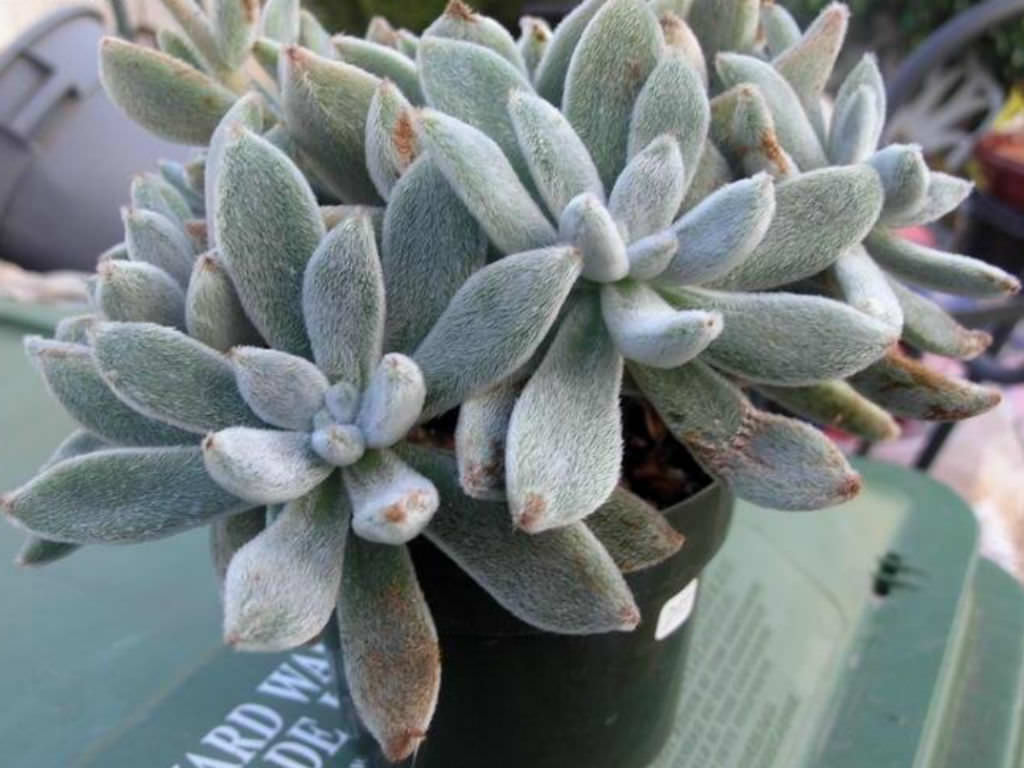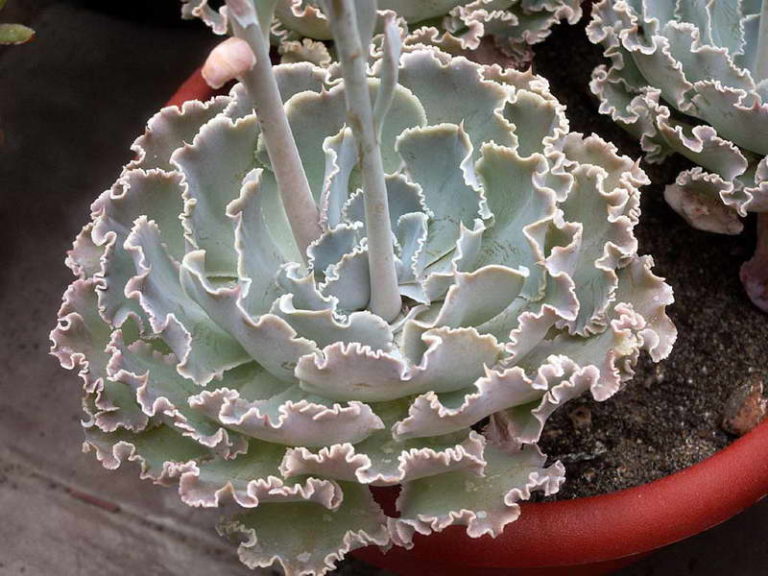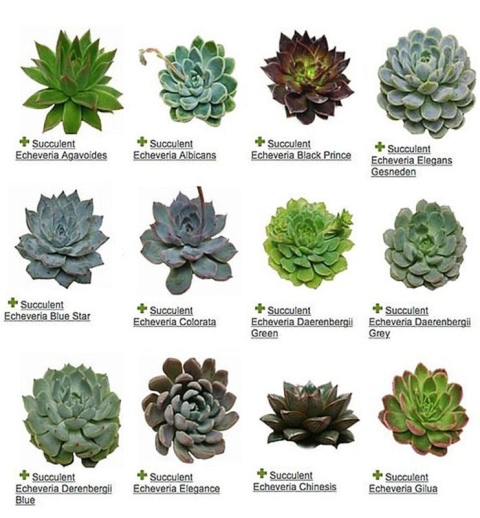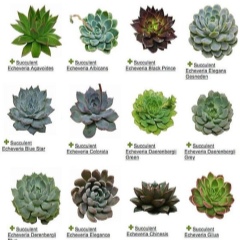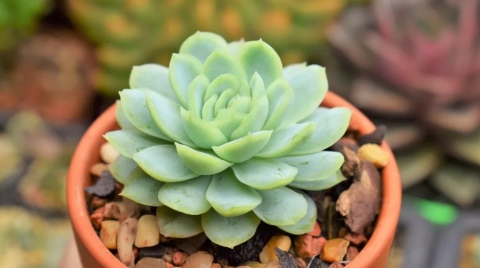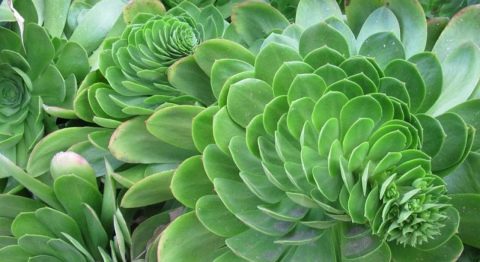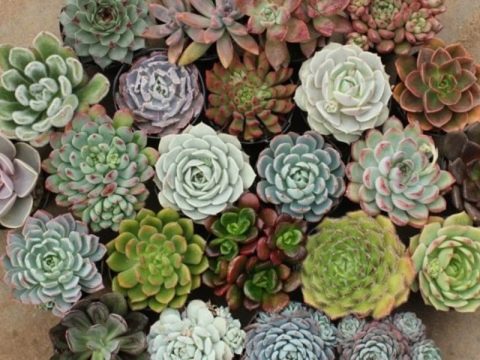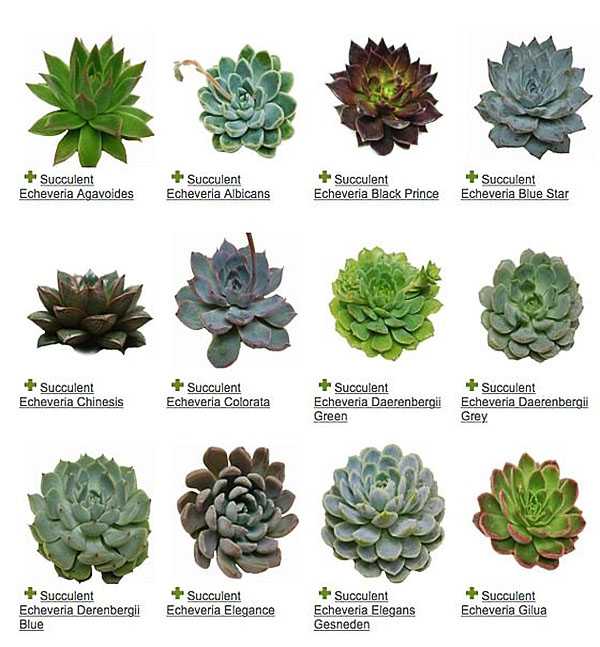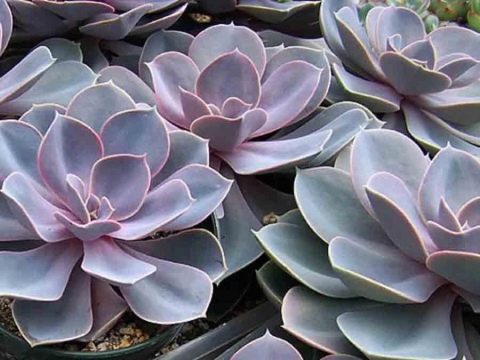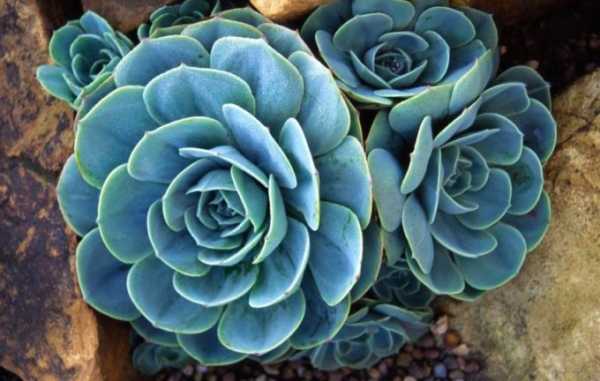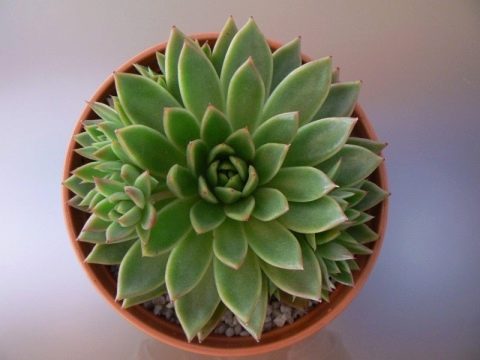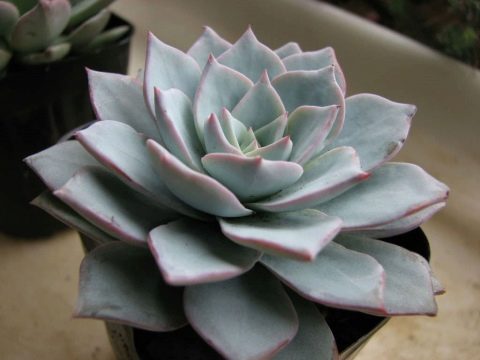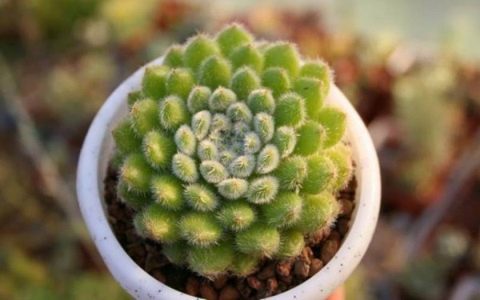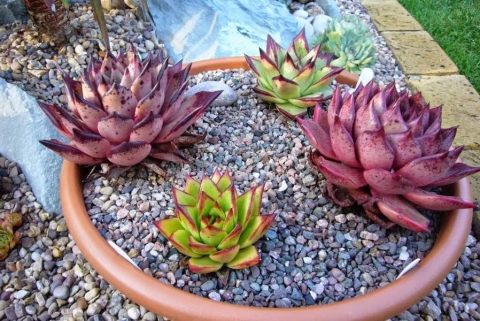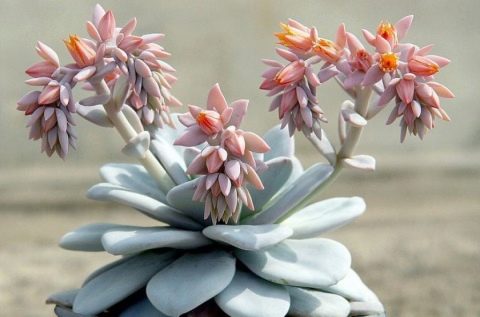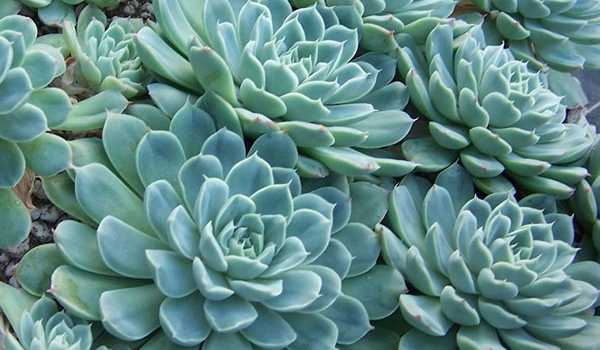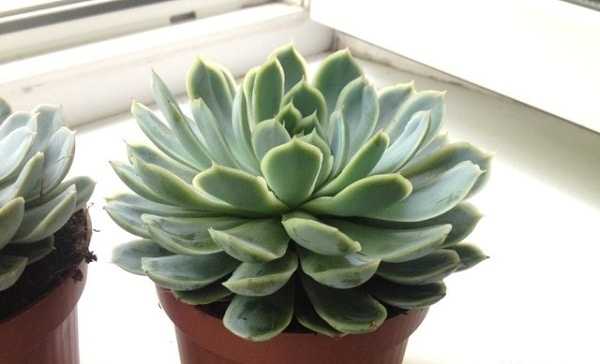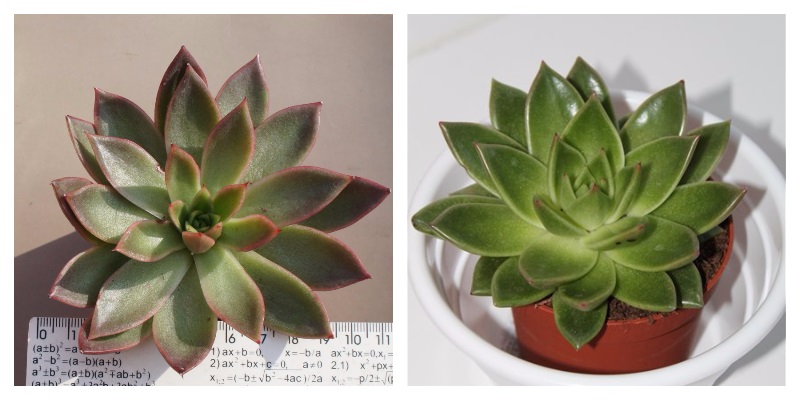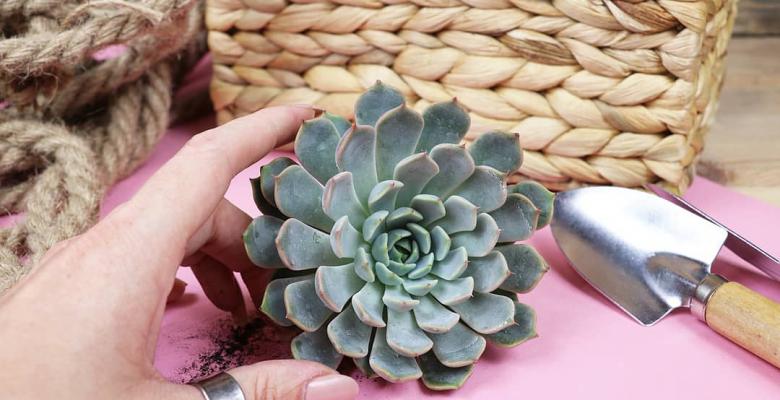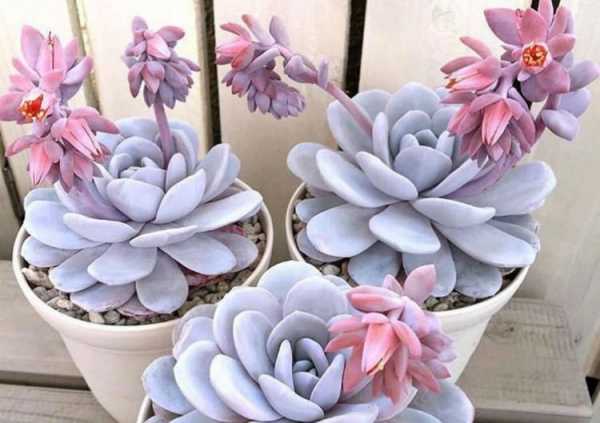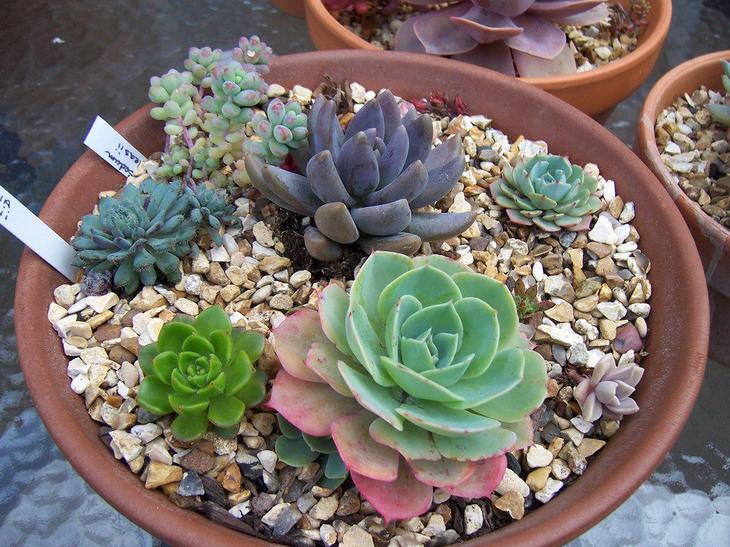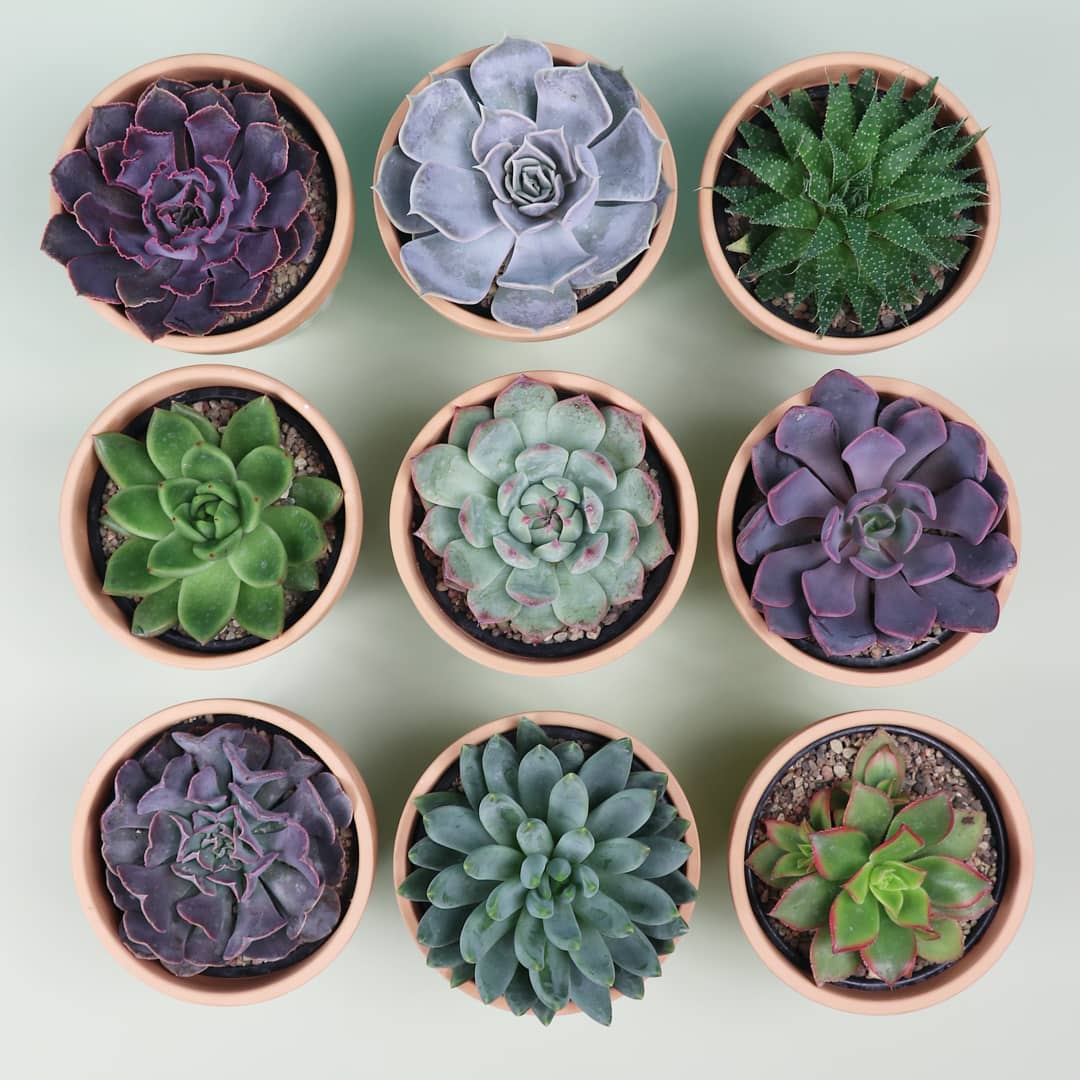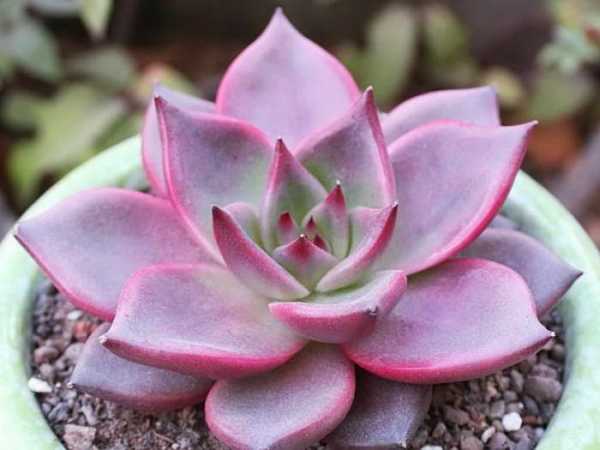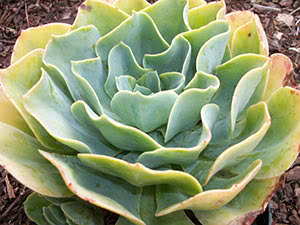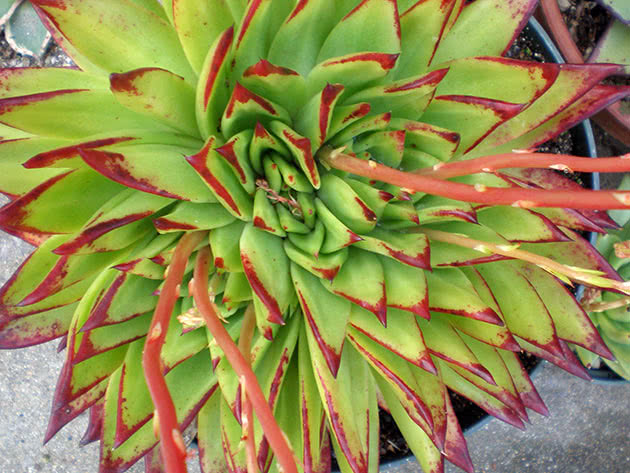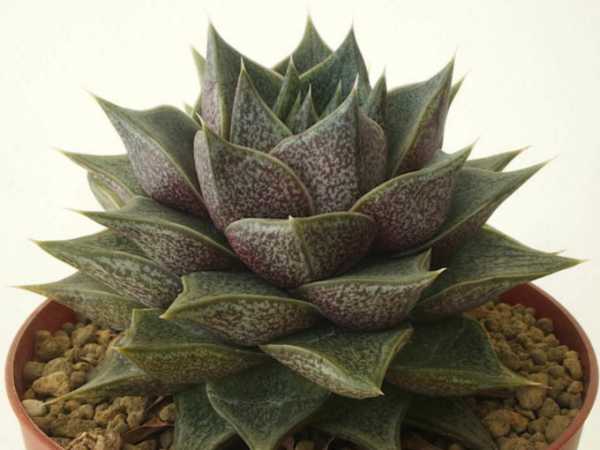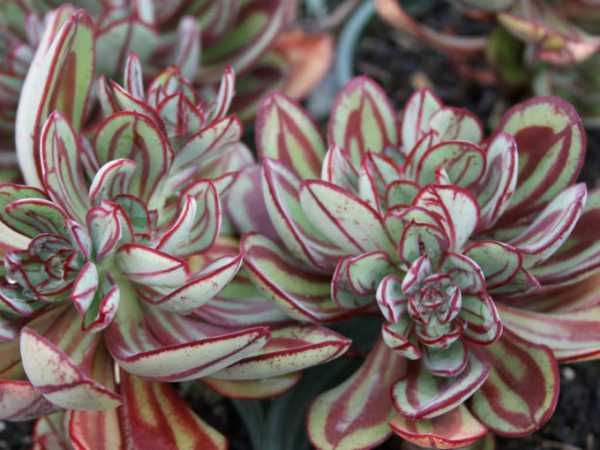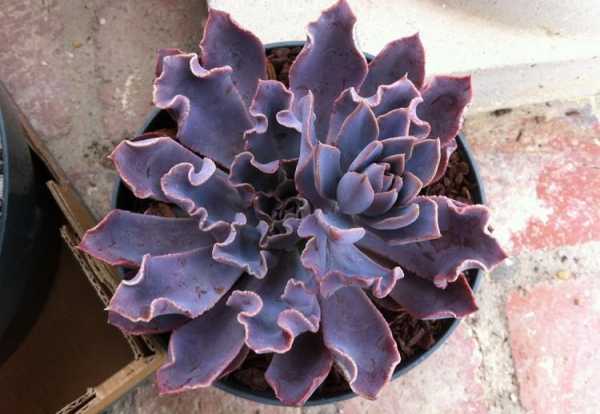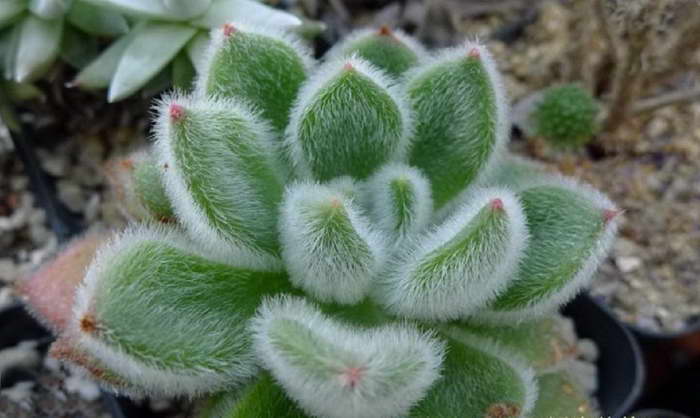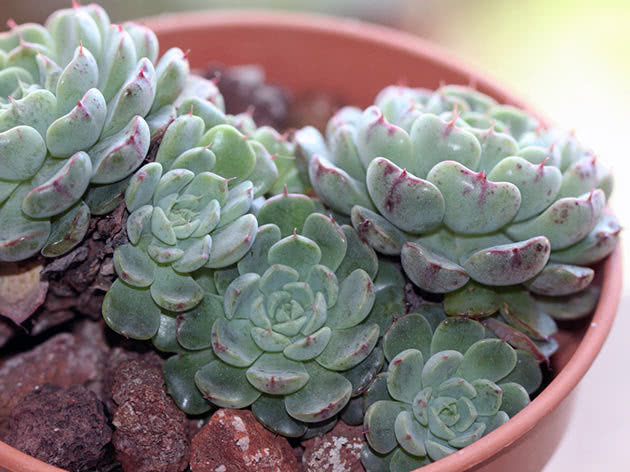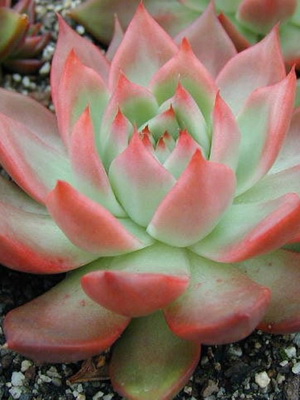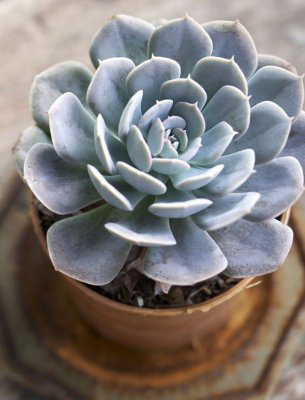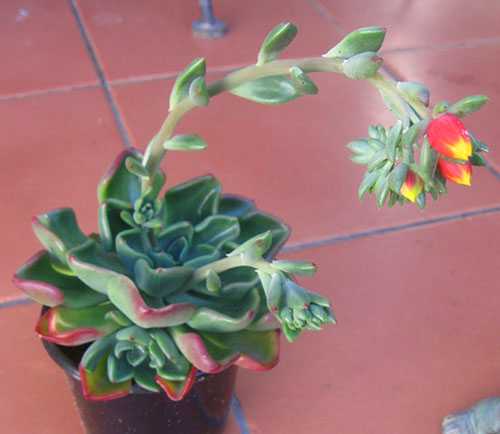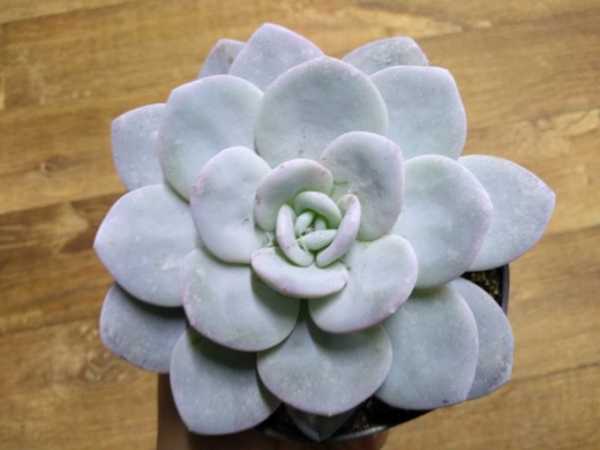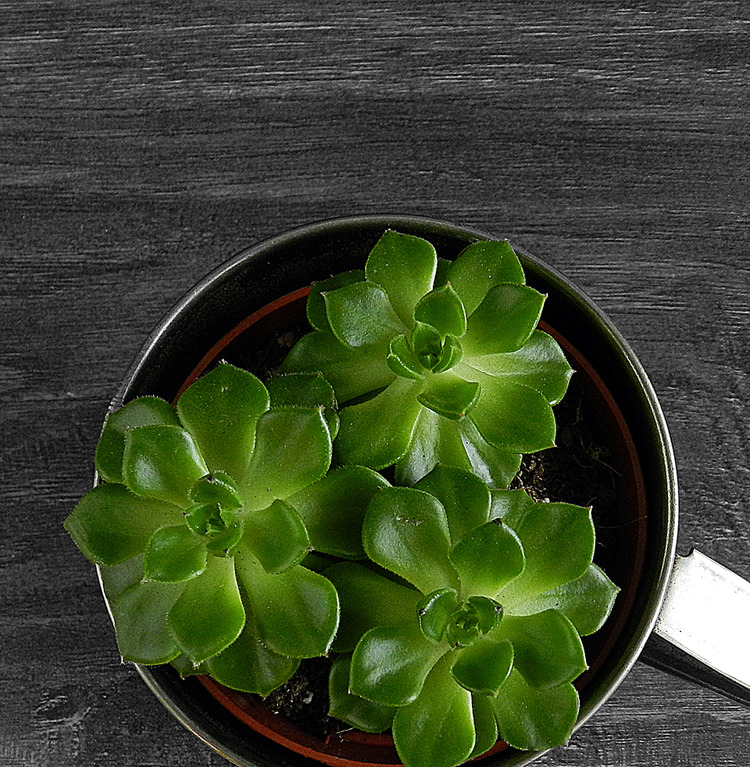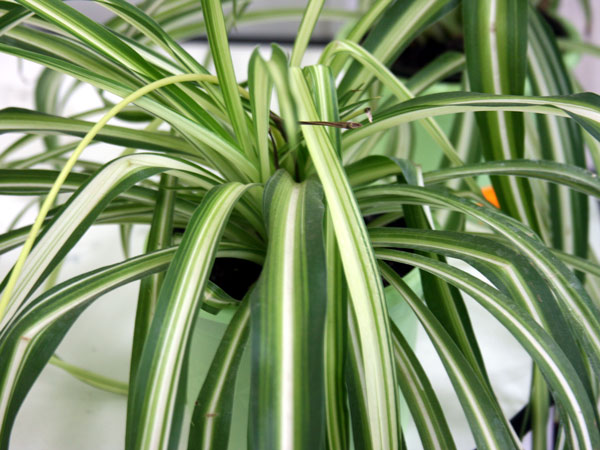Reproduction
Echeveria is propagated by seeds, leaf cuttings and lateral daughter rosettes.
When propagating by a leaf, a healthy leaf should be separated from the mother's outlet, dried for several days (5-7). After that, the outer side of the leaf is placed on wet soil or sand, slightly deepening its leg into the substrate. The roots should appear in about a month. After the formation of a small rosette, the plants are planted in small pots.

The preferred method for propagation of Echeveria by rosettes. The daughter outlet is separated from the adult plant, the cut is treated with crushed charcoal or a crushed tablet of activated carbon, dried for about a day. After that, they are planted in the ground with sand or in clean sand for rooting. With this method, the plant blooms earlier.
Seed propagation is used very rarely. First, the seeds are disinfected in a solution of potassium permanganate, then soaked in growth stimulants, dried and sown in a prepared substrate. From above, the seeds are covered with a very thin layer of sand. The soil is moistened from a spray bottle and a greenhouse is built over the container with seeds. Depending on the species, the seeds germinate from two weeks to three months.
Planting and transplanting
When buying a plant in transport soil, many strive to immediately transplant the flower into good soil. But in order to adapt to new living conditions, experienced flower growers advise not to rush to transplant: let the succulent stay in a store pot for a month. The flower must be placed in a shaded place and dried until aerial roots appear.
It is easier to adapt to new conditions for plants grown in nurseries that are as close as possible to the conditions of the place of sale. They are more expensive, but do not die for no apparent reason. They are also given the opportunity to dry out on the window. After a month, the houseplant is transplanted into a new soil mixture and a pot.
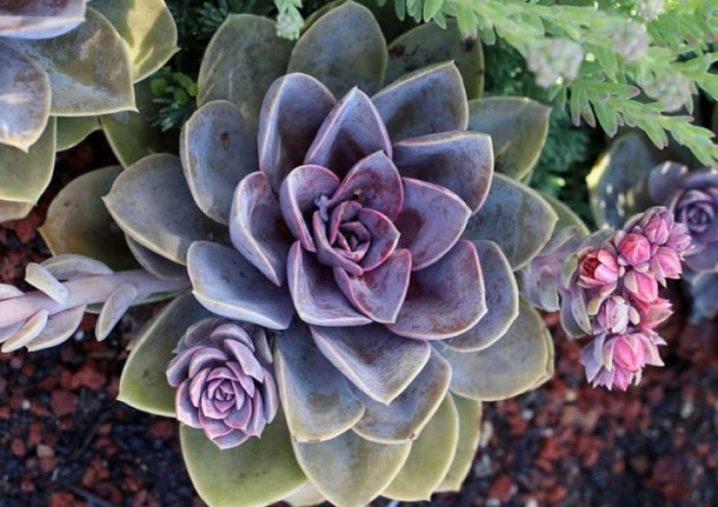
With regard to the soil, it should be noted that in nature, a stone rose grows on stones, where water only flows, but does not stagnate. The same substrate must be prepared during transplantation. Here are some suitable options:
- mix in equal proportions leafy earth, humus, sand and small pebbles;
- Mix the purchased soil for succulents with pebbles, expanded clay, broken small bricks in a ratio of 4: 1;
- Mix 3 parts of garden soil with 1 part of small pebbles, 1 part of peat and a small amount of charcoal or activated carbon.
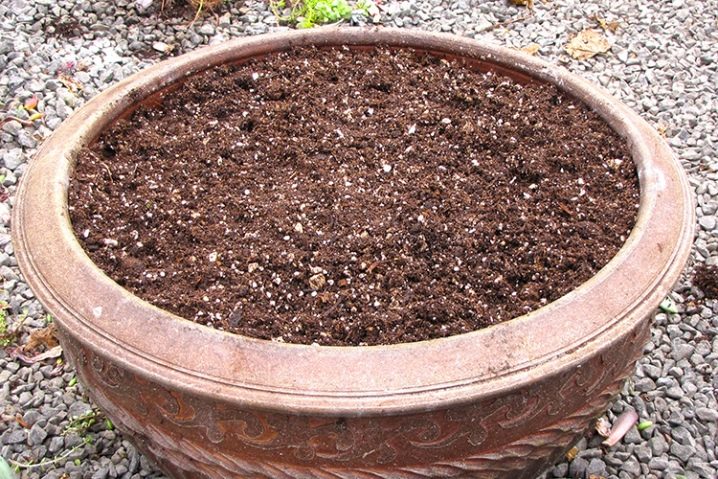
As drainage, you can use zeolites - minerals that can give and take away excess moisture.
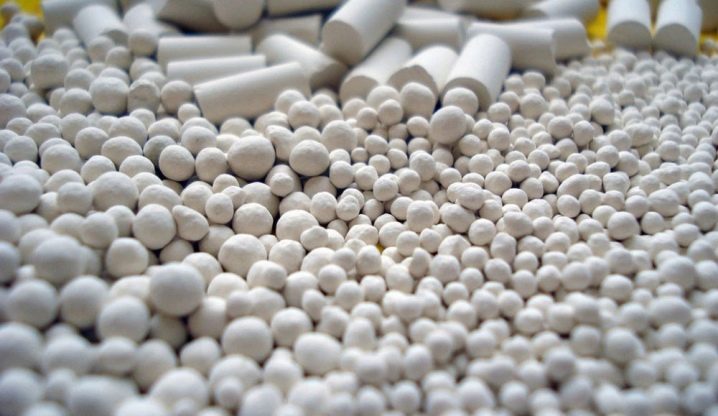
There is hardly any difficulty in choosing a flower pot - it should be 1.5 cm larger than the diameter of the plant, flat, with holes for draining water. Very small plants can be planted in mini cups. For planting several plants of the same or different species and varieties, use wide low dishes. Before transplanting, you need to carefully check the roots of flowers: cut off diseased, damaged ones, and rinse healthy ones for reliability in a weak manganese solution.

The bottom layer that is poured into the pot is drainage (various types of pebbles). The second layer is calcined for disinfection, cooled and moistened substrate, on which the plant is placed, on top - again the substrate to the root collar. In the first week, the flower is not watered.
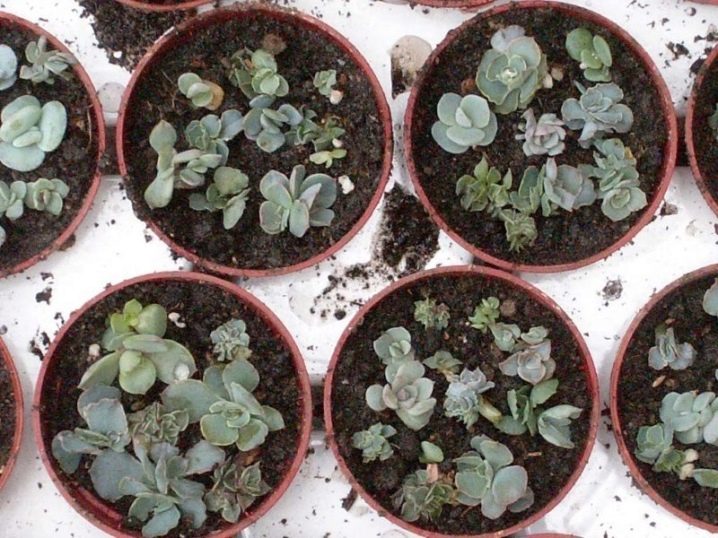
A great way to show the beauty of your favorite flowers of the Tolstyankov family is to grow them in an unusual greenhouse - a florarium. Initially, back in the 19th century, plants were planted in floor, wall, tabletop, hanging florariums that needed to create a special microclimate.Now it is more of an interior decoration, a design move that allows you to create unusually beautiful flower arrangements from succulents. Absolutely any containers are used as a flower pot:
- earthenware jugs and jars, including broken ones;
- aquariums;
- glasses;
- glass tetrahedrons;
- ceramic bowls.

Compositions behind glass look most interesting, especially if you use multi-colored sand, zeolites, moss for drainage. But at the same time, one should not forget about the substrate layer for echeveria - for beauty it can be decorated. Several recesses for plants are carefully made in the ground and specimens are planted with tweezers, given that they will grow. Such compositions are often watered with a pipette, since this must be done at the root. From above, everyone is covered with decorative pebbles and sand, and figures are installed.
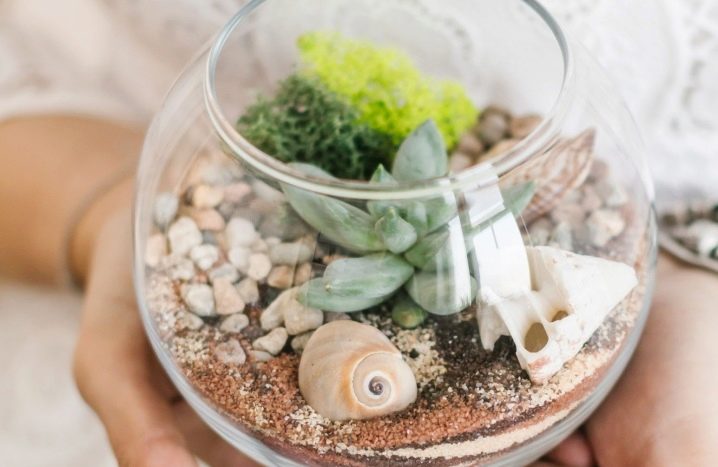
Very often, plants from other families and genera are planted in the florarium along with a stone rose: cacti, jerky, Kalanchoe, euphorbia, haworthia, lithops. The main thing is that this mix requires the same care, the amount of moisture and the plants do not interfere with each other. But still, in a year or two, the florarium will have to be expanded - the plants grow.
How to care?
Growing such beautiful and unusual flowers is a pleasure in itself. Of course, I want to take care of them so that they grow, do not get sick, and please the eye. But the special joy is the flowering of the plant. Not all species bloom at home simply because there is no pollination. But why do not those varieties that should delight with color bloom? Perhaps due to improper care. Do not expect the plants to bloom in the first year or two - they are still small.
In other cases, you need to help the rose. To do this, maintain the temperature around the flowers at 15-18 degrees for 1.5-2 months (but without covering). Plants should be exposed to light for 12-13 hours. After that, the first buds should appear. After the appearance of the peduncle, Echeveria is watered more often and fed with fertilizer. Better to buy a special complex for flowering plants. After flowering is complete, there is a dormant time with the usual frequency of watering and dressing.
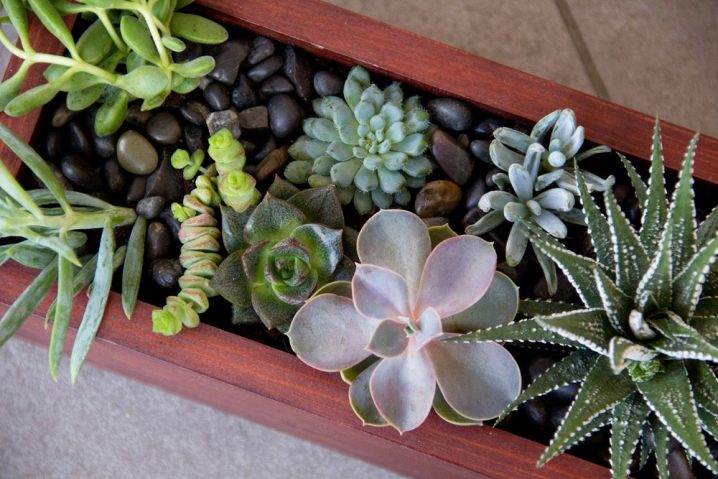
Top dressing
Since Echeveria is undemanding to soil fertility, it must be fed very carefully. From spring to autumn, mineral fertilizers are applied for cacti and succulents once a month in the form of solutions (in a half dose). In the autumn-winter period, feeding is not carried out. The same is not done even after transplanting the plant into new land for two months. For echeveria, it is not recommended to use pure organic matter and nitrogenous fertilizers.
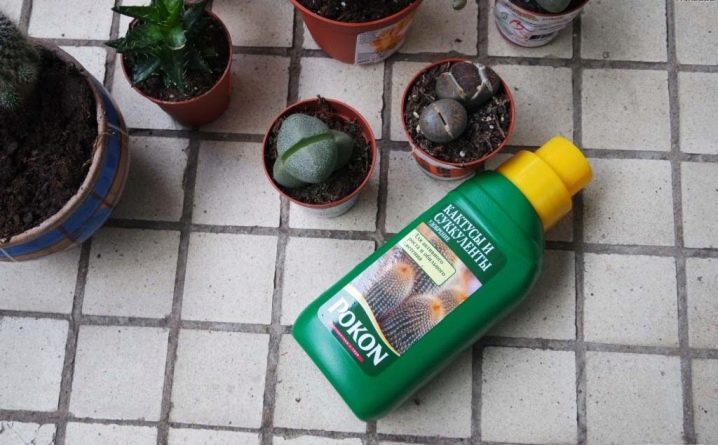
Watering
The desert plant does not require frequent watering. You need to wait until the earthen lump under the flower dries out thoroughly, only then it needs to be watered. In winter, even more rare watering will save the plant from pulling out an excess supply of water in the leaf plates, an unwanted tilt of the stem. If the temperature in the house in winter is high enough, then the rose is watered only a little less often than in summer. Before watering, water must be defended for 2-3 days, or use an aquarium when changing it (this will be a kind of top dressing).

It is advisable to water on the soil, but do not strive to wash the leaves - the plant does not need this. The water should not stagnate in the pot.
Diseases and pests
Despite its resistance to diseases and pests, echeveria miranda is attacked by insects, the spread of rot or other problems.
By observing simple precautions and watering regimes, they can be easily avoided.
- Mealybug and aphids. The main signs are called white sticky bloom on the leaves, desiccation of the plant, foliage falling. This happens when the waxy coating of the leaves is damaged. They remain unprotected and sucking insects settle in the axils of the plant to feed on them. At the first sign of an insect attack, the plant is washed with soapy water using a cotton swab and treated with special infusions (tobacco or garlic) or insecticides.
- Rot, powdery mildew.Appears in case of violation of the irrigation regime and moisture ingress on the plant itself. In this case, it is necessary to transplant Echeveria into completely clean soil, remove the damaged parts. Sometimes they resort to radical measures: they cut off the top, subsequently planting it in the ground, eliminating everything else.
- Withering. The rest of the problems appear due to the violation of the conditions of the plant and are solved by proper care. Too small a pot or insufficient watering will cause the succulent to stop growing, lack of lighting will make the leaves pale, and the high temperature in the room will cause the leaves to wrinkle and the rosette to shrink.
If the stem and leaves turn black, then the flower is cold. In these cases, the watering schedule is adjusted, the pot is moved to a cool or warmer place without drafts, and is periodically exposed to light.
Varieties and photos
Each of the representatives of the genus fascinates with something of its own, inherent only in this plant. This includes the unusual shape of the leaves, and pubescence, and the color scale, and the size of the inflorescence-basket. There are more than 3,000 varieties of groundwort that grow successfully not only outdoors, but also at home. Below are photos, names and descriptions of the species of wild rose, suitable for reproduction and care at home.
Rowley
It is a perennial succulent that is also called "strings of pearls". Rowley is better than other varieties for breeding and care at home, due to its intense growth. He comes from the African Namib Desert. This variety is distinguished by a decorative type of green shoots, which, depending on the method of placement, either hang down or spread along the ground, covering the surface. The leaves are pale green, spherical in shape, 6 mm in diameter, which are strung in the form of beads on thin shoots.
Under favorable conditions, the plant produces a peduncle in May, with lonely small white flowers collected in a basket inflorescence and spreading a pleasant delicate aroma of cinnamon.
The root system of the Rowley variety is shallow, so the pots should be wide and shallow. The optimum air humidity is 50-60%; there should not be an excess of nutrients in the soil.
The photo below shows Rowley's Rustic:
Ordinary
It is a perennial or biennial herb, widespread in the countries of northern Eurasia. Common groundwort is considered an aggressive weed, so its distribution is strictly controlled. It grows well on roadsides, fields, meadows, forests and along paths, wastelands and sand dunes, rocks, walls and scree.
The stem is erect, slightly branched. Leaves are oblong, spatulate, slightly toothed along the edges. The end of the inclined flowering shoot is crowned with a bell-shaped basket with yellow tubular flowers. Valuable honey plant. You can see what the variety Rustic Ordinary looks like in the photo below:
Large reed
This is a tall evergreen liana, which at first glance resembles common ivy. The large-lingual groundwort is native to the Natal province in South Africa, which is why the plant is also called "Natal ivy". A distinctive feature is the lance-shaped leaves, reaching a length of 8 cm, which, like all succulents, are dense, thick, filled with moisture, covered with a waxy coating.
The leaves are located on long (up to 3 m), slightly branched and woody stems, attaching themselves with small purple petioles.
The color of the leaf plate is even green or variegated, spots and yellow-white stripes are found. The main vein is reddish.
The blooming of the large-reed senezio occurs in winter, during which spherical axillary or apical (often single) baskets with small yellow flowers appear on the plant. In the photo below, the variety Krupnoyazychkovy Krestovnik:
Flat-leaved
It is a tall perennial herb that grows mainly in the Caucasus, at an altitude of 1500-2000 m above sea level. The flat-leaved groundwort forms thickets in tall-grass meadows. Its few erect shoots have a ribbed surface. The height of the stems, on which the large leaves are located, reaches 2 m. The upper leaves are ovate-lanceolate, and the lower ones are triangular-peaked. There is pubescence on the leaves and stems.
The plant blooms in the first half of summer, after which, from August to September, the seeds are warmed, which then spread by self-sowing. Inflorescences are large, paniculate-corymbose. Bright yellow tubular flowers are collected in cylindrical baskets.
Diamond-shaped
Rhombolic is a perennial Caucasian rhizome plant with numerous erect stems, reaching 2.5 m in height. Habitat - mountain forests and pre-alpine lowlands, located at an altitude of 1500-2000 m above sea level.
Broadly ovate, alternate petiole leaves covered with pubescence. The upper leaves are up to 8 cm long, and the lower ones are much longer - up to 30 cm.
Inflorescences are corymbose-paniculate, consisting of small yellow baskets. Tiny rooted seeds are carried by the wind.
General information
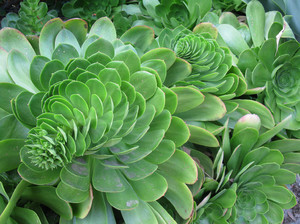 The botanical name for the stone rose is Echeveria. This species belongs to the jumbo family. The subspecies are divided into herbaceous and shrubs. The first mentions of echeveria are contained in documents dated to the 16th century. The plant was described in his writings by the Spanish scientist B. de Sahagun. He pointed out that the Aztecs used the flower for medicinal purposes, making emollients and fresheners from it.
The botanical name for the stone rose is Echeveria. This species belongs to the jumbo family. The subspecies are divided into herbaceous and shrubs. The first mentions of echeveria are contained in documents dated to the 16th century. The plant was described in his writings by the Spanish scientist B. de Sahagun. He pointed out that the Aztecs used the flower for medicinal purposes, making emollients and fresheners from it.
In the 19th century. Mexican scientist - flora researcher described this plant in more detail in his treatises and supplemented the information with detailed images. The full name of the botanist is Atanasio Eciverria y Godoy. In honor of him, the succulent was given the name Echeveria. In Russian it can be pronounced as echeveria or echeveria.
Main characteristics
Echeveria forms flattened or cylindrical leaves filled with a semi-liquid substance, collected in loose or compact rosettes. They are oval in shape, with pointed ends. The width of the leaves varies from 1 to 14 cm, the length is from 2.5 to 25 cm. In some specimens, the leaves grow up to 30 cm.The color takes on green, red, purple, pink and other shades. In some varieties, the leaves are covered with a waxy coating that looks like pubescence.
 The stone flower can be with or without a stem up to 70 cm long; there are also species with creeping and standing shoots. The roots are fibrous, located in the surface layer of the soil. A stone rose flower at home can reach a length of 50 cm. The color of the petals depends on the conditions in which the specimen grows. In dim light, they are yellow, and if you keep the plant in the sun, the color will be bright red. Often "babies" develop on peduncles, but you should not try to use them for reproduction.
The stone flower can be with or without a stem up to 70 cm long; there are also species with creeping and standing shoots. The roots are fibrous, located in the surface layer of the soil. A stone rose flower at home can reach a length of 50 cm. The color of the petals depends on the conditions in which the specimen grows. In dim light, they are yellow, and if you keep the plant in the sun, the color will be bright red. Often "babies" develop on peduncles, but you should not try to use them for reproduction.
In appearance, the gum looks like a cold-resistant rejuvenated. Planting and care at home for both succulents occurs in different ways, so it's best not to get confused. Novice growers often ruin the gum, leaving it to winter in the open field.
The rose must grow in a separate container, and when the temperature drops, as well as for the winter, it must be brought into the heat. It is also necessary to monitor the humidity of the soil and air, because a stone flower, like any native of the desert, does not like dampness.
Indoor bashful mimosa: growing and care
Growing conditions
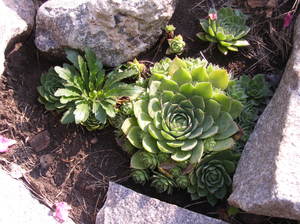 There are few such unpretentious plants as a stone rose. Home care is mostly about protection from cold and dampness. Succulent plant prefers dry air, does not tolerate spraying on the leaves. Grows best in full sunlight. Can withstand shading but is best avoided. Temperature requirements differ at different times of the year.
There are few such unpretentious plants as a stone rose. Home care is mostly about protection from cold and dampness. Succulent plant prefers dry air, does not tolerate spraying on the leaves. Grows best in full sunlight. Can withstand shading but is best avoided. Temperature requirements differ at different times of the year.
Echeveria care at home
Growing echeveria from seeds
Reproduction of echeveria by seeds is the most difficult way to get a new plant: during flowering, you need to pollinate the flower with your own hands, observe the ripening of the seeds and collect them in time. Then the seeds are laid out on the surface of a sandy-peat substrate, slightly pressed without covering, and kept in a bright place at a temperature of 20-25 ˚C in conditions of high air humidity, for which the crops are covered with film or glass.
As a container for growing seedlings, it is advisable to use a container with drainage holes through which excess moisture will flow out.
If you are attentive and careful, then in 2-3 weeks you will have many sprouts, and when they develop three real leaves, you can plant them in separate pots and place them on the lightest windowsill in the apartment.

The echeveria plant is not afraid of heat, dry air, or direct sunlight, therefore it grows well, develops and blooms on windowsills oriented to the south. From spring to autumn, homemade echeveria feels comfortable in the room temperature normal for the season, and in winter you need to find a room for it where the temperature will not rise above 10 ˚C. If this is not possible, and the plant will winter in a warm room, then try at least to make it enough light: some amateurs complain that their echeveria stretched out over the winter and its stems were bare, and the reason for this trouble is poor lighting at high air temperatures ...
Watering and feeding echeveria
Echeveria is watered with settled or filtered water at room temperature, when the substrate in the pot is completely dry. With more frequent watering, there is a risk of decay of the lower leaves and roots of Echeveria.
Make sure that the water does not stagnate near the stem and that excess water flows out of the pot without hindrance. If Echeveria begins to feel thirsty at home, its leaves will become soft and begin to wrinkle.
As for air humidity, Echeveria, like all succulents, is indifferent to this indicator. She does not need and even harmful both spraying and bathing in the shower.
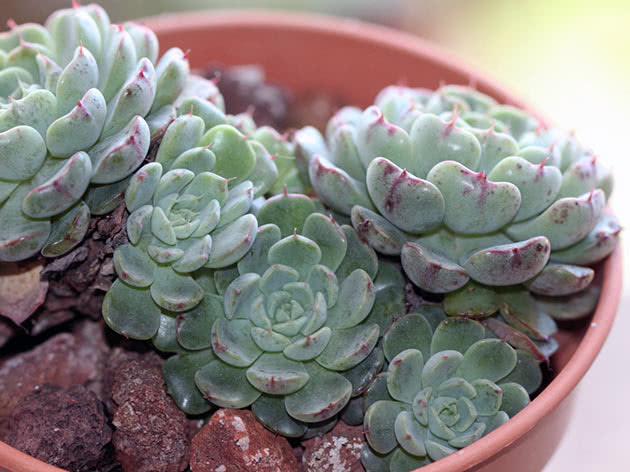 In the photo: Growing echeveria in a pot in an apartment
In the photo: Growing echeveria in a pot in an apartment
Care should be taken with feeding echeveria, since an excess of fertilizer in the substrate stimulates putrefactive processes in the leaves. Mineral complexes for cacti in the form of solutions are added to the substrate once a month during the period of active growth
At the beginning of autumn, feeding is stopped. If you often renew the soil in the pot, then you do not need to apply top dressing at all.
Transplantation and reproduction of echeveria
Young echeveria need to change the pot and substrate every spring, for adult plants it is enough to change the dishes and soil once every 3-4 years. Echeveria pots must have drainage holes. First, a layer of drainage material is laid in a shallow pot - pebbles or expanded clay, after which the plant is transferred from the old pot to a new one and the free space is filled with a soil mixture consisting of loamy soil (3 parts), peat (1 part), expanded clay (1 part) and charcoal (handful).

If Echeveria has already settled in your apartment, you can propagate it in vegetative ways, which are simpler to perform and more reliable than growing from seeds. For example, stem cuttings: in mid-March, apical cuttings with several leaf rosettes are separated from the mother plant and easily pressed into the soil of sand and a small amount of compost soil. They contain rooting cuttings in bright light and a temperature of 22-24 ˚С, from time to time moistening the soil. Echeveria cuttings are rooted in 7-10 days, after which they are transplanted into permanent pots.
They practice in indoor floriculture and propagation of echeveria by a leaf, but this method requires experience and skill, because you need to be able to separate the large lower leaves from the plant without damage.The leaves are dried for several hours, then placed horizontally on the sand and regularly moisten the soil, preventing it from overmoistening. The roots will begin to appear in a month, but a full-fledged plant will only form in 3-4 months.
Care
Transfer after purchase
Not only echeveria - any plant must be transplanted after purchase. The thing is that the soil in which it is sold is not intended for the long-term presence of the plant in it. This is, so to speak, a staging post. Pick up a shallow wide pot for echeveria, after rinsing it with boiling water, pour soil and drainage inside, and replant. After transplanting, quarantine the plant, away from the rest of your plants.
Lighting
Choose a place for echeveria that is well lit, where, nevertheless, you can organize light shading on the hottest days. Cover the window with a curtain at noon, and in the morning and evening, let your flower bathe in the rays of the sun - the more light the Echeveria catches, the brighter its color will be, and the more magnificent it will bloom. In spring, summer and on warm autumn days, you can take the pot out to the loggia or balcony.
Temperature regime
 Echeveria is not afraid of the summer heat, however, in the summer hours it is preferable to keep the plant indoors, where the thermometer shows from + 22 to +27 degrees.
Echeveria is not afraid of the summer heat, however, in the summer hours it is preferable to keep the plant indoors, where the thermometer shows from + 22 to +27 degrees.
Moreover, the succulent is not at all against sudden changes: it is not afraid to freeze at night and at +16, and even +14. In winter, lower the degree a little more, but not lower than +7.
Humidity and watering
Echeveria tolerates drought perfectly, but waterlogging - even a slight one - will instantly cause rotting of the roots. Therefore, make sure that the soil between waterings dries out to a third of the depth: dip your finger into the ground, and you will immediately understand whether you need to water or should you wait. Moreover, this rule is observed both in summer and in winter.
Take water for irrigation separated, at room temperature. Chlorinated tap water is not suitable, as is the liquid from the river, rain or melt. It is worth getting a household filter or getting used to settling water (a day in a vessel without a lid).
The succulent does not tolerate spraying: the rosette can rot even from a tiny droplet that gets inside.
Top dressing
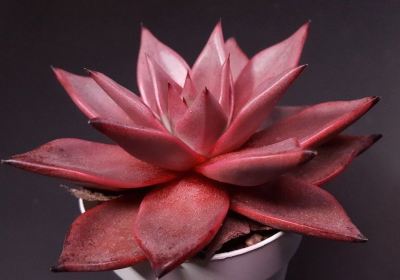 A succulent plant does not require frequent feeding: 1 feeding per month is enough for it. In the summer season, you can use a special fertilizer for succulents or for cacti (weakly diluted).
A succulent plant does not require frequent feeding: 1 feeding per month is enough for it. In the summer season, you can use a special fertilizer for succulents or for cacti (weakly diluted).
The main requirement: a sufficient amount of potassium and phosphorus, and a minimum of nitrogen. Excess nitrogen will cause the succulent to become soft, lose its elasticity and color, and begin to rot. Apply fertilizer only after abundant watering, in dry soil it will burn the roots.
In winter, during the dormant period, you should not feed - Echeveria rests during these months.
Planned transplant
Since the roots of Echeveria are located in the upper layers of the soil, choosing a container for planting, stop at a shallow and stable vessel, the diameter of which will be 3-4 centimeters larger than the circumference of the rosette. The material is clay or ceramics.
Soil mixture is a substrate for succulents or cacti. It is easy to find in any flower shop. For self-preparation of the soil, you will need the following components:
- Brick chips - 1 part;
- Coarse river sand - 1 part;
- Overripe leafy soil - 1 part;
- Clay-sod land - 3 parts.
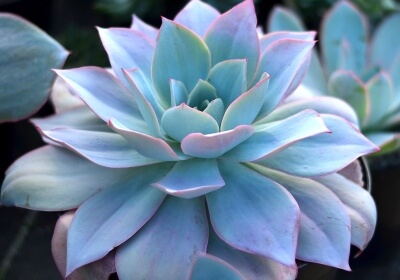 Transplant scheme:
Transplant scheme:
- Lay drainage (pebbles or expanded clay chips) on the bottom of the container and 2/3 of the soil mixture.
- Remove the plant from the old pot, shake off excess soil, if necessary, remove the damaged roots, and place in a new pot.
- Fill with soil on top, but make sure that the root collar is at ground level. Around it, you can lay a little medium-fine gravel: it looks beautiful and will facilitate the access of air to the roots.
Popular species and varieties with photos
Echeveria agave (Agavoides) is a perennial herb. The stem grows up to 15 cm. The rosette is dense, the leaves are elongated, 6-9 cm wide, silvery-light green with reddish tips.

Echeveria white-haired (Leucotricha) is a bush 0.15-0.2 m tall with a dense tomentose edge of a dark red color. The rosette is loose, the leaves are inversely lanceolate, 60-100 mm long and 25 mm wide, covered with soft white hairs with a red tip.

Echeveria hairy (Pilosa) has softly pubescent leaves and a bare stem.

Echeveria cushion (Pulvinata) is distinguished by velvety leaves of bright green color. It blooms with yellow-orange flowers. The leaves are obovate, 65 mm long and 40 mm wide.

Echeveria humpback-flowered Pearl of Nuremberg (Perle von Nurnberg) is a hybrid variety with pinkish-gray leaves and an erect stem.

Echeveria humpback-flowered Metallica is a bush 0.3-0.7 m high. There are aerial roots on the stem. The rosette is loose, leaves 30 cm long and 15 cm wide, broad-footed, gray-pink. The flowers are pale red with a yellow center.

Echeveria crimson (Purpusorum) is one of the highest (up to 0.7 m), leaves are softly pubescent, located throughout the stem. The underside and edges of the leaf are reddish.

Echeveria Harms (Harmsii) is a weakly branching bush. Aerial roots grow on the shoots, the rosette is loose. Leaves are gently pubescent, in the form of an elongated rhombus, 20-40 mm long and 10-15 mm wide. In the upper part of the sheet there is a reddish stripe along the contour. The petals are red with a yellow top.

Echeveria Desmet (Desmetiana) - the most resistant species, can grow in relative shade and withstand excessive watering. Has a compact rosette of bluish leaves. The growing long stem turns into ampelous over time. In the middle of summer, yellow-orange flowers appear on the lateral petioles.

Echeveria Derenberg (Derenbergii) is a perennial herb. It grows up to 18 cm. Numerous shoots spread along the ground. The rosette is dense, the leaves are wide pterygoid with a rounded apex, 30-40 mm long and 20-25 mm wide, the color of the leaves is pale green with a bluish-gray tint and a red edging. The flowers are red-yellow.

Echeveria graceful (Elegans) is a perennial herb 5 cm high. The lateral daughter dense rosettes are located on the stem. Shoots spread on the ground and are able to root themselves. The leaves are elongated, 3-6 cm long and 1 cm wide, the color of the leaves is light green with a blue waxy bloom. The flowers are yellow-red.

Echeveria Lau (Lauii) is a stemless herb with a large rosette (18-20 cm in diameter). The leaves are fleshy, pale blue in color, due to a matt waxy coating, they have an almost white hue, 6 cm long and 3 cm wide. The flowers are large, orange in color with a waxy coating. The variety grows slowly, requires a lot of sun and dry wintering.

Echeveria multi-stem (Multicaulis) is a profusely branching shrub 20 cm high. The rosette is loose, the leaves are inversely ovoid, 25 mm long and 15 mm wide, dark green with red edges. Flowers 1-1.3 cm long, red with a yellow center.

Echeveria knotty (Nodulosa) is a succulent shrub 0.5 m high. The rosette is loose, the leaves are inversely ovoid, 5-8 cm long and 1.5-5 cm wide. The color of the leaves is bright green with a pink underside and with a red edging. The flowers are red with a yellow center.

Echeveria Black Prince is a hybrid variety. Leaves are red-brown in color. Blooms in late summer. Demanding on bright light, often affected by mealybugs.

Echeveria Sho (Shaviana) - the plant resembles a head of cabbage. The stem is shortened, the leaves are tightly pressed against each other, flat, not juicy, with a wavy edge. It blooms in the middle of summer with two or three peduncles, on which several dozen flowers bloom in turn. In winter, most of the leaves fall off. Not resistant to mealybug.

Echeveria bristly (Setosa) is a perennial herb. The stem grows up to 10 cm in height. Rosette 15 cm in diameter. The leaves are rich green with sparse long white hairs, leaf length 5 cm and width 2 cm. Flowers are yellow-red.

3.Types of echeveria:
3.1. Echeveria agave-Echeveria agavoides
Succulent plant, forming basal rosettes of green, thick, succulent, hard, triangular leaves up to 20 cm in diameter. Grow singly or form dense herbaceous mats. Adult plants form stems up to 5 cm in height. During the flowering period, plants emit tall, thin, leafless peduncles, at the top of which are attractive bell-shaped pink flowers. The tips of the petals are often tinted with a contrasting greenish or yellow tint. Among the subspecies, Echeveria Miranda is distinguished - the leaves of which are painted in 2 contrasting shades - light green and bright burgundy or bluish green and pink, bluish green and salmon.
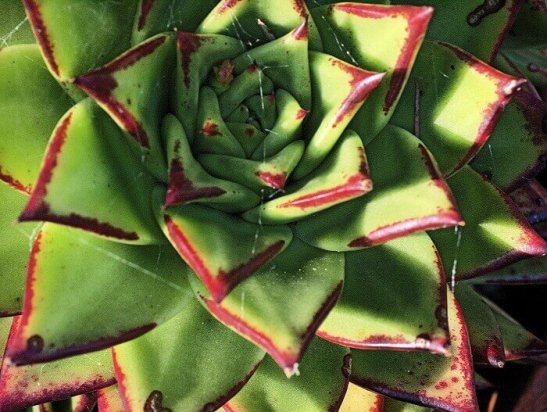
3.2 Echeveria graceful - Echeveria elegans
An evergreen plant with light green, bluish or gray, thick leaves in a rosette. Numerous daughter rosettes on long whiskers form large colonies with age, because of this feature, this subspecies received its second name - “chicken with chickens”. The rosettes can be up to 50 cm in diameter. The flowers are pink or red, there are 5 - 10 pcs. on the tops of tall peduncles.
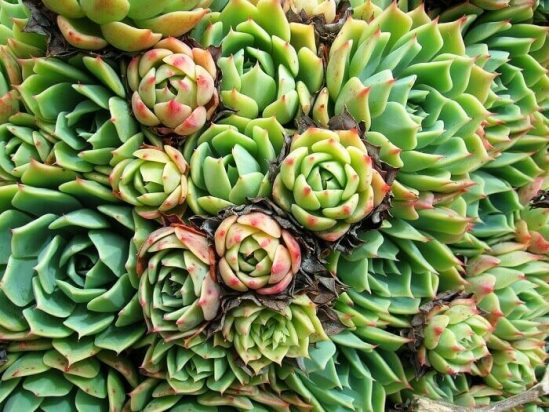
3.3. Echeveria "Pearl of Nuremberg" - Echeveria "Perle von Nurnberg"
Plants of this subspecies have rounded, spoon-shaped, slightly concave leaves with very delicate shades, including lilac, gray, bluish, pink. The center of the rosette has a lighter pink tint. Often forms single rosettes; with age, the plants may develop a short stem.
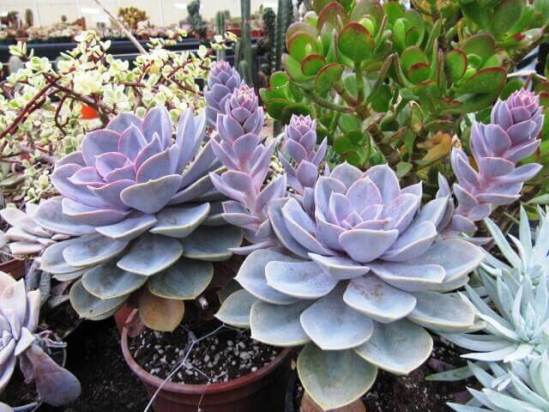
3.4. Echeveria "Black Prince" - Echeveria "Black Prince"
The darkest-colored type - the leaves are triangular, pointed. The inside of the leaf rosettes is light green or yellow, while the tips of the leaves are almost black. Plants often form daughter rosettes.
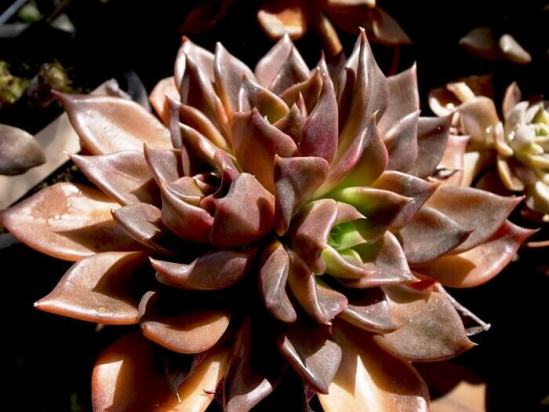
3.5 Echeveria Laui
A very delicate bush with bluish-gray, rounded leaves. The shade of the leaves forms a blue waxy coating that can be easily removed with the slightest touch. Peduncles are strong, thick, slightly curved at the top. The flowers are light pink with bluish bracts. Leaf rosettes of this type resemble rose flowers in shape.
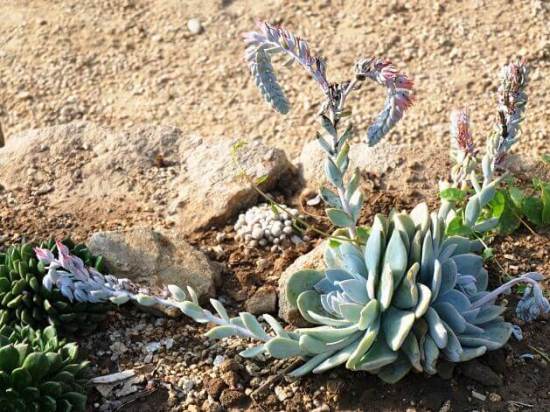
3.6. Echeveria Derenberg - Echeveria derenbergii
Rosettes of this subspecies have rounded outlines and consist of many thick, juicy leaves of light green or bluish green. The leaf surface may be slightly pubescent. During the flowering period, each rosette can produce many erect peduncles with very bright, pinkish yellow bell-shaped flowers.
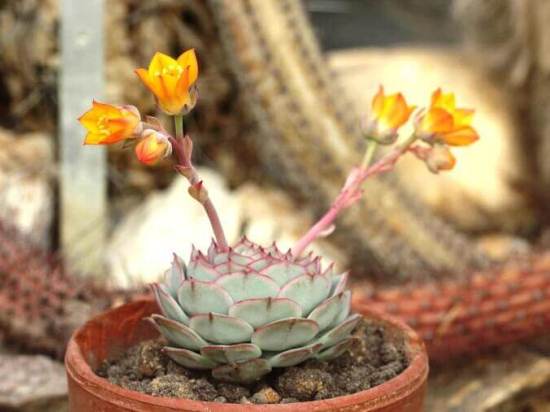
3.7. Echeveria purpusorum - Echeveria purpusorum
Pointed triangular leaves of this species often have specks and stripes - for example, black, burgundy, brown or gray specks may be present on light green leaves. In good lighting, the leaves additionally acquire a pink or reddish tint. The surface of the leaves is glossy.

3.8 Echeveria shaviana
Quite large plants for their species - they reach a diameter of 10 cm, are basal leaf rosettes, consisting of bluish spatulate leaves. Along the upper edge, the leaf blades have a beautiful corrugated crest. When grown in the sun, the edges of the leaves are often tinged pinkish. Peduncles are low, thick, bear a few delicate pink flowers at the top.
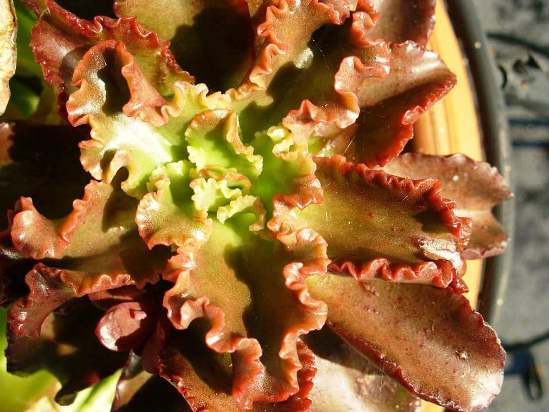
3.9. Echeveria pulidonis - Echeveria pulidonis
Attractive, slow growing, leafy succulent with thick, succulent, pointed leaves covered with a bluish waxy coating. The edges of the leaf plates are painted in a contrasting burgundy shade. Peduncles are tall, erect, bent at the apex, bearing several yellow flowers.
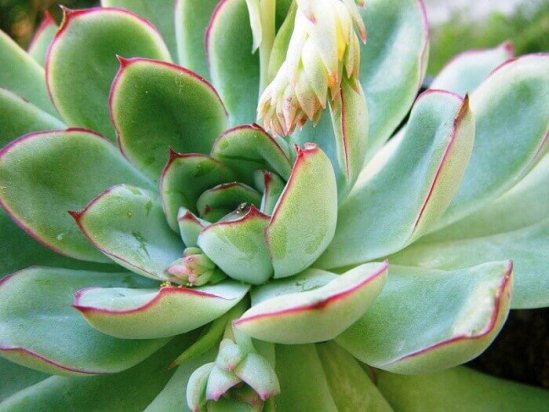
You may also be interested in:
Haworthia
Sedum
Fat woman
Rejuvenated

